-
Produktkatalog
-
- Sale
-
Silber Schmuckstücke
-
Alle in der Kategorie Silber Schmuckstücke
- Anhänger - Schmuck, Silber
- Armbänder
- Ringe
- Ohrringe
- Moldavite
- Halsketten
- Schmuck aus Gold
- Torques, halsketten
- Bernstein, Schmuck
- Silberschmuck-Sets
- Broschen
- Silber und Edelsteinen
-
Thematische Schmuckkollektionen
-
 Alle in der Kategorie Thematische Schmuckkollektionen
Alle in der Kategorie Thematische Schmuckkollektionen
- Lapponia Juwelen
- VIKINGS
- Jugendstil-Juwelen
- Dinosaurier-Shop
- Mythologiesammlung, alte Kulturen
- Nautischer Silberschmuck
- Gepresste Schmudstuecke
- Granatschmuck
- Mystica Silber Kollektion - Anhänger
- Mystica Silber Kollektion - Ohrringe
- Silberne Halskette
- Historischer Schmuck
- Zodiac, silver pendants
- Wikingerschmuck
- Anhänger - Historia
-
-
-
Schmuckstücke
-
Alle in der Kategorie Schmuckstücke
- Amulette, Talismane aus Zinn
- Bronze - Schmuck
- Vergoldeter Schmuck
- Schnüre, Schatullen, Anhänger
- Geschmiedeten Schmuck, torques, bracelet
- Modeschmuck
- Schlüsselanhänger
- Schmuck mit Steinen
- Mittelalterliche Krone
- Historischen Repliken aus Bronze
- Chakra, reiki
- Messing Schmuck, Importe Irland
- Abzeichen
- Clans Abzeichen
- Original celtic jewelry
-
-
Waffen
-
Alle in der Kategorie Waffen
- Sharp Blades - throwing knives
- Schwerter
- Axt, Schlagwaffen
- Dolche
- Messer
- FakeSteel armory
- Streitkolben, Streithämmer
- Langen Messer, Sachse
- Lanzen, Speere
- Bögen
- Damast Messer
- Falchionen und Langmesser
- Swiss army knives
- HMB - Waffen
- Feuerwaffen
- Wikinger Messer
- Hirschfänger
- Pillow Fight Warriors
- Messer - Zubehör, Anspitzer
- Küchenmesser
-
-
Rüstungen
-
T-SHIRTS, Boots - Rock Music
-
Keramik
-
Lederprodukte
-
Hornprodukte
-
Schmiedearbeiten, Mintage
-
Bushcraft, reenactment, handwerk
-
 Numismatik
Numismatik
-
Schuhe, Kleidung
-
Rahmentrommeln
-
Historische Brettspiele
-
Figuren, Dekorationen
-
Wollprodukte
-
 Holzprodukte
Holzprodukte
-
 Wargaming
Wargaming
-
Lizenzierte Produkte - Filme, Spiele
-
Alle in der Kategorie Lizenzierte Produkte - Filme, Spiele
- Warhammer 40K
- 2001 Space Odyssey
- AC/DC
- ALIEN
- Antman
- Assassin's Creed
- Asterix
- Avatar
- Avengers - Infinity War
- Back to the Future
- Batman
- BEETLEJUICE
- Big Bang Theory
- Blade Runner
- Bud Spencer - Terence Hill
- CBGBs
- Clockwork Orange
- Deadpool
- Deep Purple
- E.T. the Extra-Terrestrial
- Frank Zappa
- FULL METAL JACKET
- GAME OF THRONES
- Ghostbusters
- Godfather - Der Pate
- Gremlins
- GUARDIANS OF THE GALAXY
- HAN SOLO MOVIE
- Harry Potter
- IRON MAIDEN
- IT
- Jaws
- James Bond 007
- Jurassic Park
- King Kong
- Knight Rider
- KISS
- LED ZEPPELIN
- LOONEY TUNES
- LORD OF THE RING
- Magic the Gathering
- Marvel
- VIKINGS
- Metallica
- Metro Exodus
- Mortal Kombat
- MR PICKLES
- NASA
- NIRVANA
- Peaky Blinders
- Pearl Jam
- Pink Floyd
- Planet der Affen
- Pokémon
- Predator
- Queen
- Rambo
- RICK AND MORTY
- Robocop
- SPIDERMAN
- STAR WARS
- Suicide Squad
- SUPERMAN
- Teenage Mutant Ninja Turtles
- The Doors
- The Witcher
- Thor Ragnarok
- Vikings
- World of Warcraft
- Rocky
- Terminator
- Die Drachenwache
-
-
 Magik
Magik
-
Bücher, Karten, Autoaufkleber
-
Historische Zelte
-
Skulpture, Garden Decor
-
 Met, Wein
Met, Wein
-
 Moldavite, Mineralien, Fossilien
Moldavite, Mineralien, Fossilien
-
Kosmetik
-
Archäologie, Geologie
-
Interior Design
-
 Weihnachtsdekorationen, Glasperlen
Weihnachtsdekorationen, Glasperlen
-
Aromatherapie
-
FILM und Requisiten
-
Alle in der Kategorie FILM und Requisiten
- Rüstung - Film und LARP, Polyurethan
- FakeSteel armory
- Kostümverleih historische kostüme
- Karnevalskostüme zu vermieten
- Carneval costume accessory
- Kostümverleih - Teile des Kostüms
- Theater Requisiten Verleih
- Mittelalterliche Zelte mieten
- Historisches Kunsthandwerk und Werkzeuge – Vermietung
-
-
 Bushcraft
Bushcraft
- Naav
- Arma Epona
- Großhandel Lose
- geschenkgutscheine
- PREISNACHLASS
-
- Einloggen
- Registrieren
- Grosshandel
- Kontakt
- Land (Deutsch)
- Währung ($ - USD)


Es befinden sich keine Artikel im Warenkorb
- Waffen
- Langen Messer, Sachse
- SCRAMASAX von Beagnoth, ohne Inschrift
The Seax of Beagnoth (Thames scramasax) is a long single-edged knife from 10th-century (Anglo-Saxon). It was found in the River Thames in 1857 (now exhibited at the British Museum in London). It is a prestige weapon with inlaid copper, bronze and silver wire. On one side of the blade is the inscription of the twenty-eight letter Anglo-Saxon runic alphabet, as well as the name "Beagnoth" in runic letters. Runes on the blades have magical function. The inscription Beagnoþ or Beagnoth ᛒᛠᚷᚾᚩᚦ (a male name), is probably a name that of the maker or original owner of the blade.
The seax was found by Henry J. Briggs in the River Thames near Battersea. It was originally described as the Scramasax of the Franks, of which examples are very rare in England.
Inscribing runes on weapons has a long tradition in northern countries. This is an esample from Edda, poem Sigrdrífumál. The valkyrie Sigrdrífa teaches the hero Sigurd how to engrave runes on his sword:
"Sigrúnar þú skalt kunna,
ef þú vilt sigr hafa,
ok rísta á hialti hiǫrs,
sumar á véttrimum,
sumar á valbǫstum,
ok nefna tysvar Tý"
"Victory runes you must know
if you will have victory,
and carve the on the sword's hilt,
some on the grasp
and some on the inlay,
and name Tyr twice."
Our replica is a simple one without runes. Because handle was not preserved we found our inspiration in Ulm Museum, Germany.
- Material: high-carbon spring steel CSN 14 260 (54SiCr6)
- Total length: 72cm
- Blade length: 55cm
- Max. blade thickness: 5mm
- Max. blade width: 4.2mm
- Wooden handle: 4.2 x 18.2 cm (2 cm thick)
- Blade: sharp
- Manufactured by Arma Epona smithy



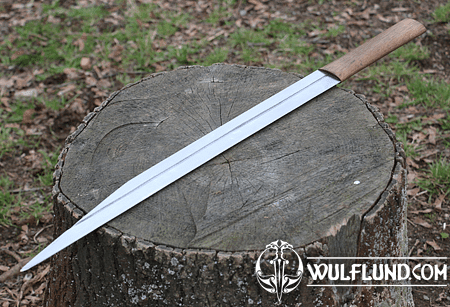





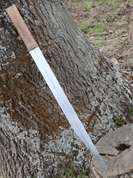
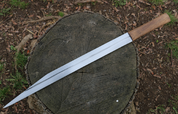
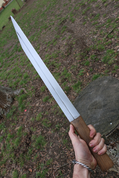
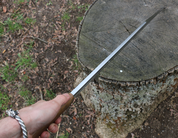
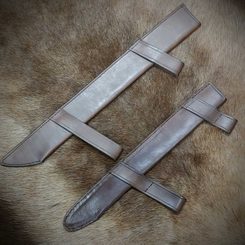
![SCRAMASAX VON BEAGNOTH, OHNE INSCHRIFT - LANGEN MESSER, SACHSE{% if kategorie.adresa_nazvy[0] != zbozi.kategorie.nazev %} - WAFFEN{% endif %}](http://i00.eu/img/602/300x300/c0iq0rny/1025.jpg)
![SCRAMASAX VON BEAGNOTH, OHNE INSCHRIFT - LANGEN MESSER, SACHSE{% if kategorie.adresa_nazvy[0] != zbozi.kategorie.nazev %} - WAFFEN{% endif %}](http://i00.eu/img/602/300x300/f2fdc6fi/23479.jpg)
![SCRAMASAX VON BEAGNOTH, OHNE INSCHRIFT - LANGEN MESSER, SACHSE{% if kategorie.adresa_nazvy[0] != zbozi.kategorie.nazev %} - WAFFEN{% endif %}](http://i00.eu/img/602/300x300/2rthqvr3/23480.jpg)
![SCRAMASAX VON BEAGNOTH, OHNE INSCHRIFT - LANGEN MESSER, SACHSE{% if kategorie.adresa_nazvy[0] != zbozi.kategorie.nazev %} - WAFFEN{% endif %}](http://i00.eu/img/602/300x300/aq5zqthp/23481.jpg)
![SCRAMASAX VON BEAGNOTH, OHNE INSCHRIFT - LANGEN MESSER, SACHSE{% if kategorie.adresa_nazvy[0] != zbozi.kategorie.nazev %} - WAFFEN{% endif %}](http://i00.eu/img/602/300x300/14w7uiph/23482.jpg)